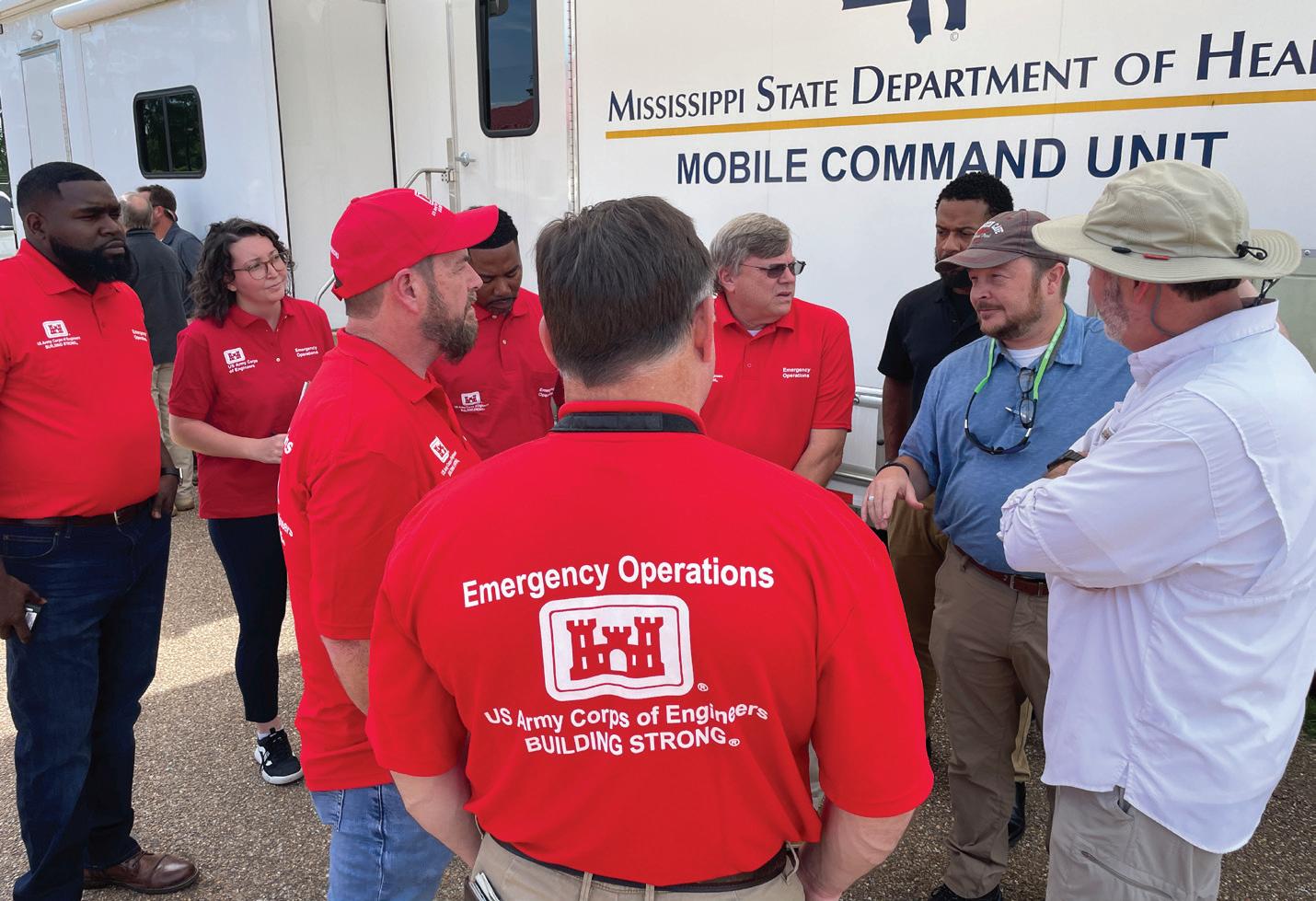
4 minute read
USACE Serves on Unified Response Team for Water Crisis
MODERNIZING WATER INFRASTRUCTURE – VICKSBURG DISTRICT
BY SABRINA DALTON
During late August of this year, the U.S. Army Corps of Engineers (USACE) was knee-deep supporting the country with mission assignments that USACE is familiar with, such as wildfires, floods, and hurricanes. One unexpected crisis ramped up USACE for an enterprise-wide, unified response to a not-so-familiar mission assignment: drinking water supply.
The upper Pearl River, which courses through north Jackson, Mississippi, and supplies water to the Ross Barnett Reservoir, experienced flooding that prompted USACE’s Vicksburg District to activate its emergency operations center (EOC) at level 2 on Aug. 27 to provide direct and technical assistance to the state of Mississippi, affected counties, partners, and sponsors.

U.S. Army Corps of Engineers Vicksburg District engineers were on site at the O.B. Curtis Water Treatment Plant, Sept. 1, 2022, after receiving a FEMA ESF#3 mission assignment to perform initial assessments.
USACE PHOTO BY SABRINA DALTON
Just as the floodwaters began receding, another crisis arose. The chemical composition of the water in Ross Barnett, which supplies raw water to the O.B. Curtis Water Treatment Plant (WTP), changed so that it compromised the WTP’s ability to function properly, cutting off the water supply to more than 150,000 residents.
On Aug. 29, the city of Jackson (COJ) declared a “water system emergency” and the state requested an “emergency measures declaration.” The next day, a federal state of emergency was declared, authorizing the Department of Homeland Security (DHS) and the Federal Emergency Management Agency (FEMA) to coordinate disaster relief efforts.
USACE received a FEMA mission assignment (MA) on Sept. 1 to provide technical assistance to the COJ. As part of the overall MA, USACE was tasked with developing a “Resiliency Playbook” to assist with long-term improvements to the O.B. Curtis and J.H. Fewell water treatment facilities.

WWW.CEE.LSU.EDU | WWW.GRADSCHOOL.LSU.EDU
(ADVERTISEMENT)
Anyone within USACE’s enterprise with water, wastewater, or water supply experience who could work on this challenge at the WTPs was sought out to assist.
Within the first two days of USACE’s MA, a Vicksburg District team had boots on the ground at O.B. Curtis and J.H. Fewell to begin performing assessments to determine what the unified command could do to assist in repairing the two water treatment facilities. The unified command was composed of USACE, the Mississippi Emergency Management Agency, the EPA, FEMA, the city of Jackson, and was overall led by the Mississippi State Dept of Health.
The reports that USACE’s initial assessment team produced were the target items for everyone to begin working on that helped restore water pressure and drinkable water.
USACE personnel from Baltimore District Washington Aquaduct, U.S. Army Engineer Research and Development Center, Mississippi Valley Division, Vicksburg District, Mobile District Water and Wastewater Technical Center of Expertise, and Walla Walla District Cost Engineering Center of Expertise worked together to develop a “Resiliency Playbook.”
Once water pressure and water quality were restored, USACE’s role transitioned to long-term solutions, developing a list of more than 60 projects to include in the “Resiliency Playbook” that will continue to improve the water infrastructure.

WWW.AMERICAS-ENGINEERS.COM
(ADVERTISEMENT)
The Vicksburg District will be the long-term project manager and will continue to support Jackson when the FEMA mission assignment ended in October. Katy Breaux, a district senior project manager with experience in environmental infrastructure programs, will be the continuity for the implementation of the playbook.
“Sections 592 for the state of Mississippi and 219 [Water Resources Development Act of 1999 as amended in 2007] projects specifically for the COJ as well as Planning Assistance to States program under general investigations authority are solutions that have been identified to help.”
Not only did USACE work as an enterprise to deliver water supply solutions, but something even greater was realized from working as a whole-of-government team.
“We strengthened our relationships with our state and federal partners, working side by side. Edith [U.S. Army Engineer Research and Development Center’s Environmental Laboratory Research Environmental Engineer Edith Martinez-Guerra, Ph.D.] was doing water quality samples and working with the EPA to discuss what needed to be repaired. Working closely with FEMA and the Department of Health, those with the expertise who’ve been doing surveys on the plants for years, was instrumental in the level of federal support that went to help people,” Breaux concluded.

GET THE UPCOMING PRINT EDITION DELIVERED TO YOUR HOME OR OFFICE FOR FREE.
GO TO WWW.AMERICAS-ENGINEERS.COM/PRINT-SUBSCRIBE/










